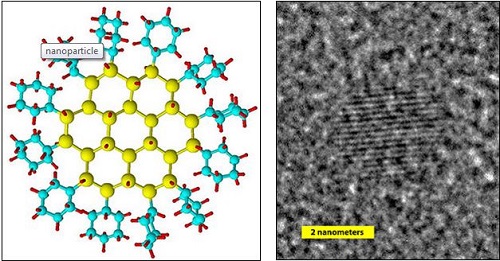If it’s true that good things come in small packages, then the National Institute of Standards and Technology (NIST) can now make anyone working with nanoparticles very happy.
NIST recently issued Reference Material (RM) 8027, the smallest known reference material ever created for validating measurements of these man-made, ultrafine particles between 1 and 100 nanometers (billionths of a meter) in size.
All good — but what does this mean for solar energy?

At left, a structural model of a typical silicon nanocrystal (yellow) stabilized within an organic shell of cyclohexane (blue). At right, a high-resolution transmission electron microscope photograph of a single silicon nanoparticle.
In-Depth Story:
RM 8027 consists of five hermetically sealed ampoules containing one milliliter of silicon nanoparticles—all certified to be close to 2 nanometers in diameter—suspended in toluene. To yield the appropriate sizes for the new RM, the nanocrystals are etched from a silicon wafer, separated using ultrasound and then stabilized within an organic shell.
Particle size and chemical composition are determined by dynamic light scattering, analytical centrifugation, electron microscopy and inductively coupled plasma mass spectrometry (ICP-MS), a powerful technique that can measure elements at concentrations as low as several parts per billion.
“For anyone working with nanomaterials at dimensions 5 nanometers or less, our well-characterized nanoparticles can ensure confidence that their measurements are accurate,” says NIST research chemist Vytas Reipa, leader of the team that developed and qualified RM 8027.
Silicon nanoparticles such as those in RM 8027 are being studied as alternative semiconductor materials for next-generation photovoltaic solar cells and solid-state lighting, and as a replacement for carbon in the cathodes of lithium batteries.
Another potential application comes from the fact that silicon crystals at dimensions of 5 nanometers or less fluoresce under ultraviolet light. Because of this property, silicon nanoparticles may one day serve as easily detectable “tags” for tracking nanosized substances in biological, environmental or other dynamic systems.
Editorial Reference:
National Institute of Standards and Technology (NIST). “World’s smallest reference material is big plus for nanotechnology.” From NIST Tech Beat: September 24, 2014.









Comments